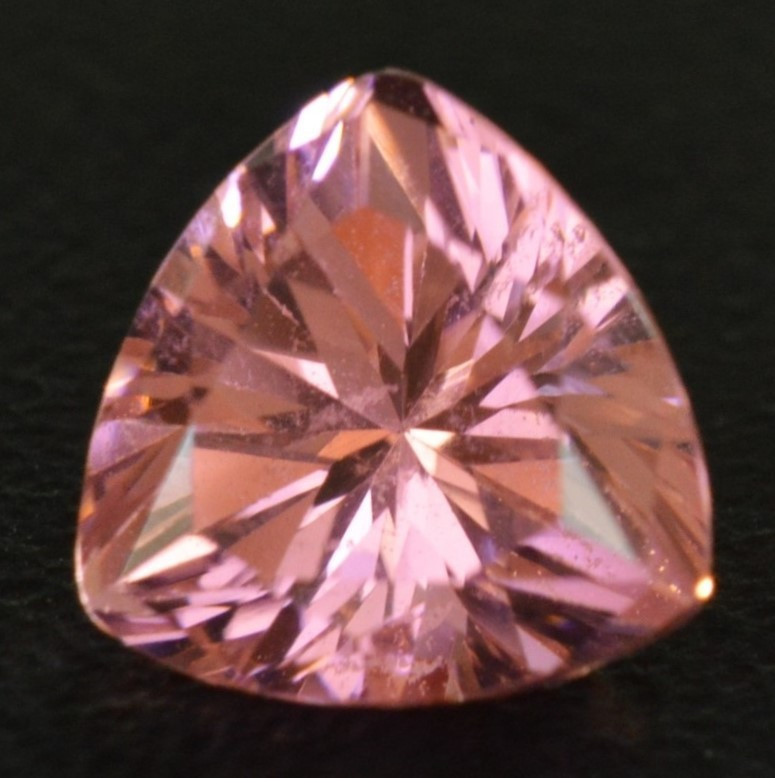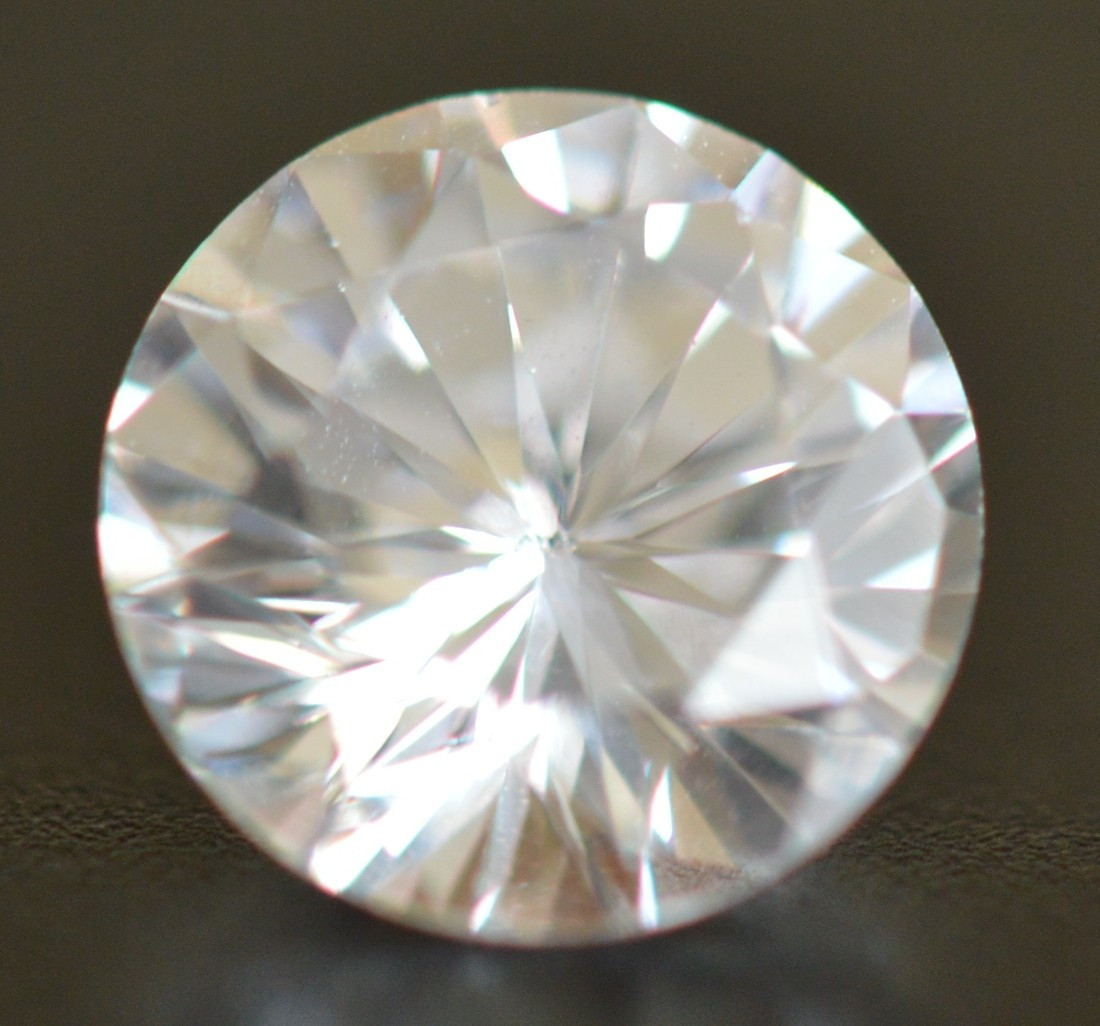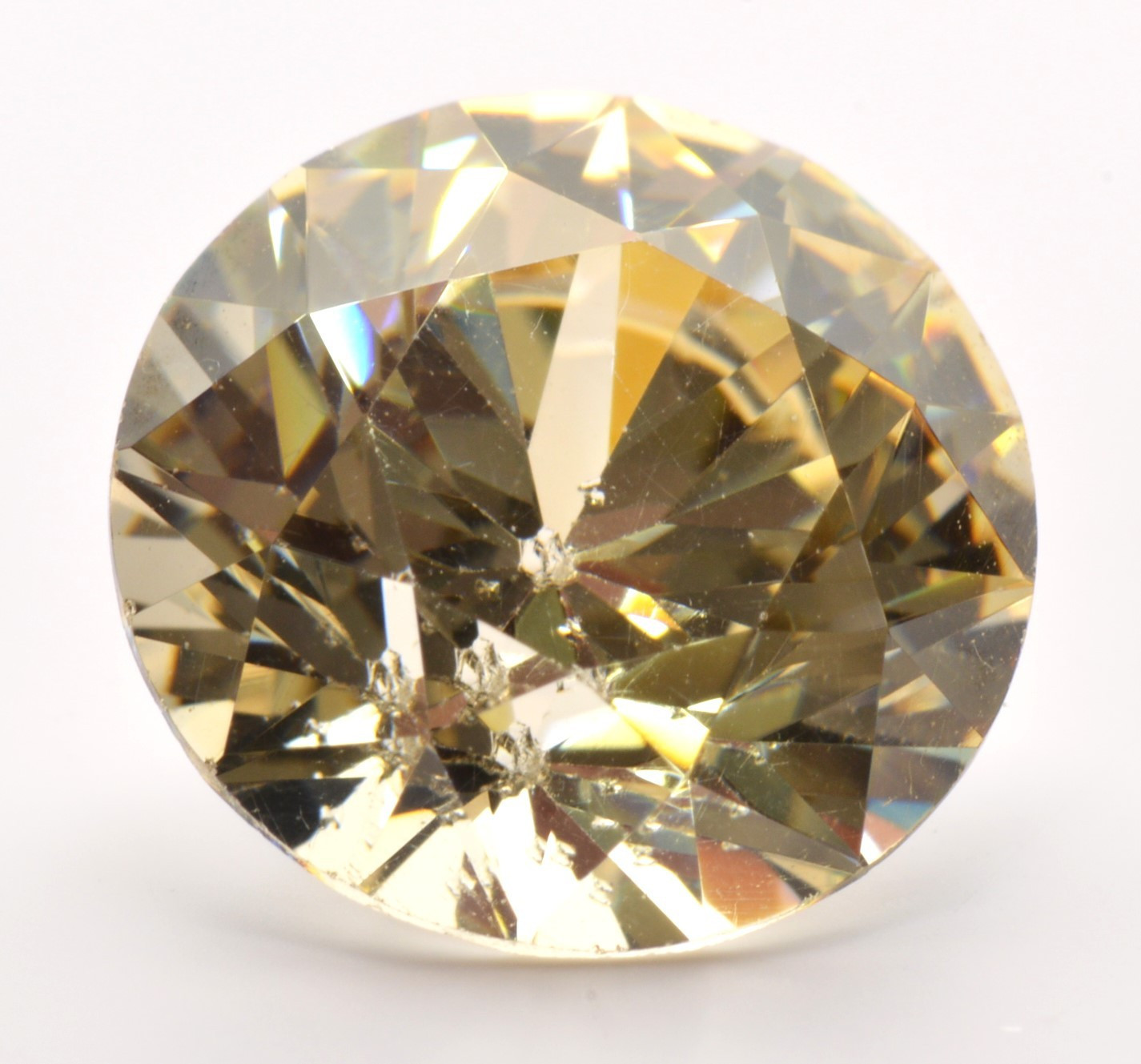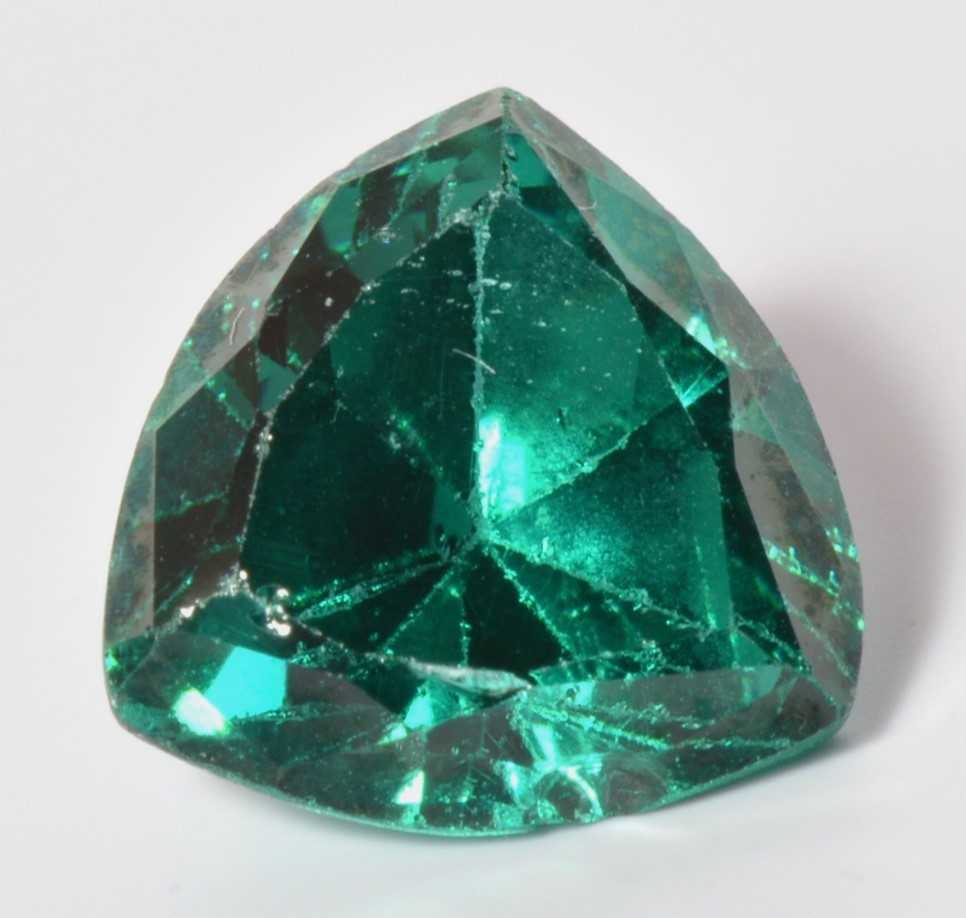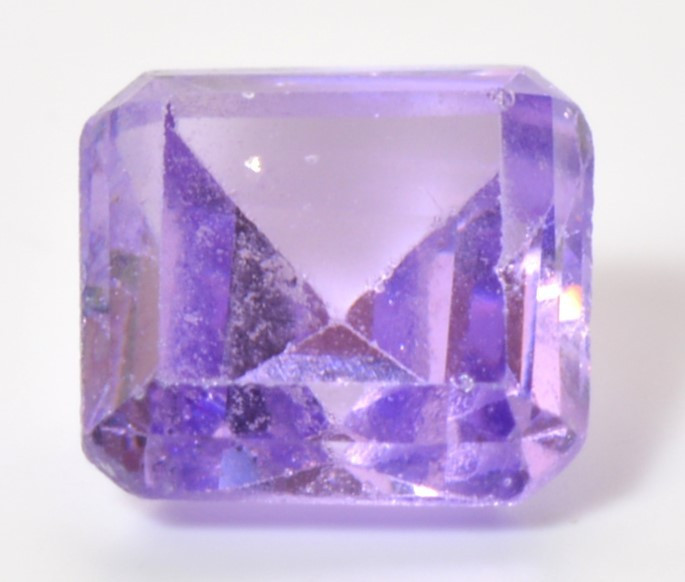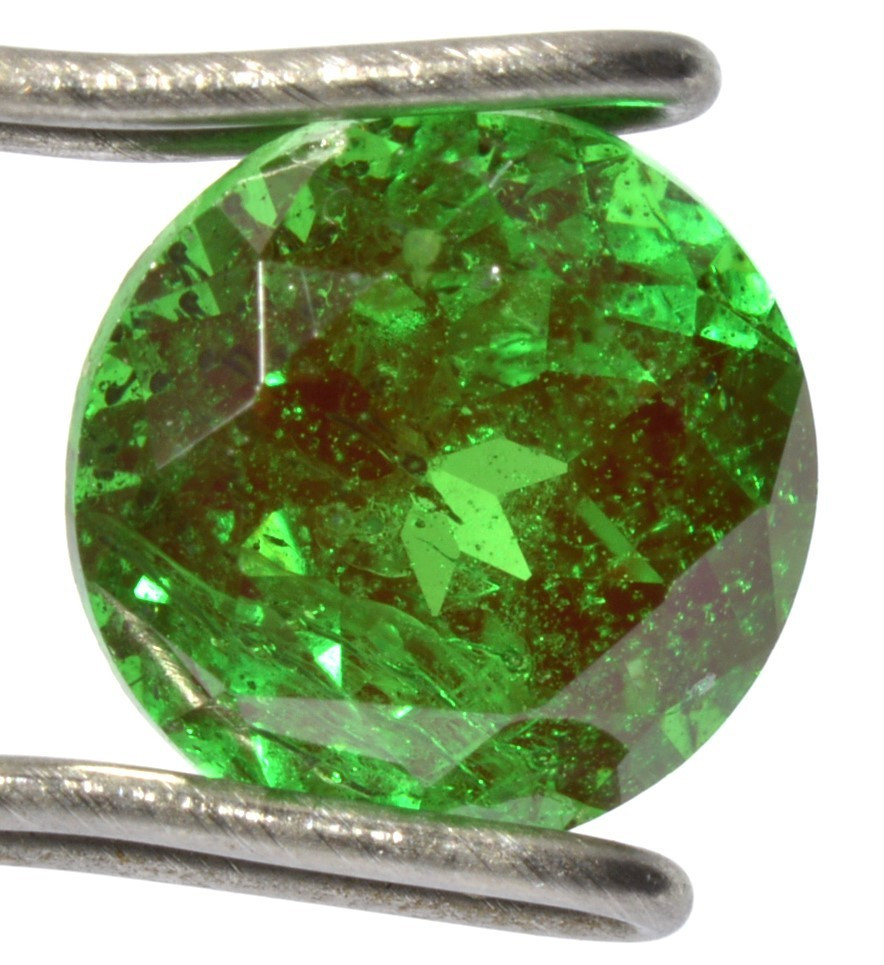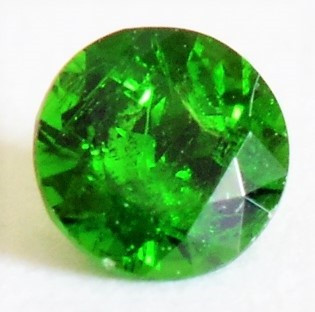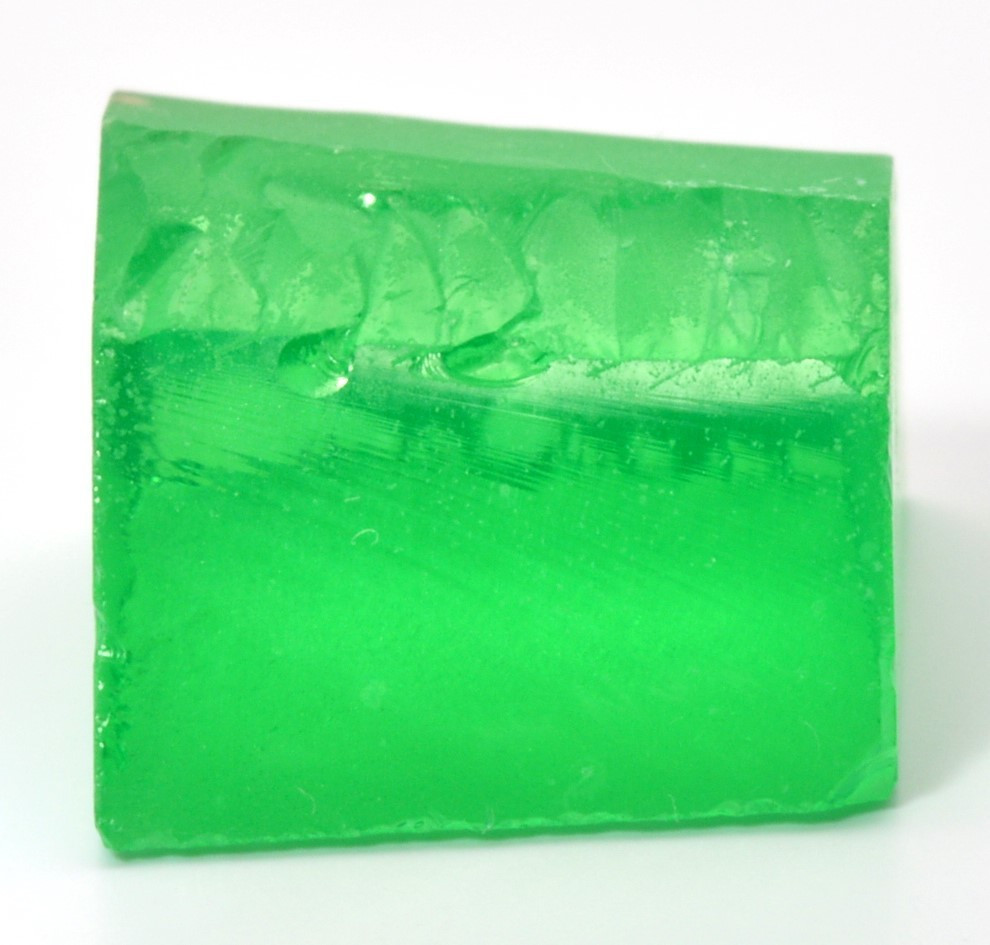Pink Yttrium Aluminum Garnet (YAG)
Synthetic Garnets: Magnetism & Color
Overview
The detailed investigation of Garnets on our website gemstonemagnetism.com would not be complete without addressing Synthetic Garnets. Although these are technically not true synthetics, this group of man-made materials have the same basic chemical structure as natural Garnet, with a crystal habit that is cubic and singly refractive (isotropic). Although they are transparent and have high brilliance, high dispersion, and are made in a wide variety of attractive colors, these materials are never manufactured specifically for use in the gem industry. And although many of these Synthetic Garnets have high magnetic susceptibility like natural Garnets and may show a Pickup response to a magnet, they are not manufactured with the intent to mimic natural Garnets.
True synthetic silicate Garnet crystals that duplicate the chemical formulas of the six species of natural gem Garnet- Pyrope, Almandine Spessartine, Uvarovite, Grossular, and Andradite- have been produced for research purposes only. These true synthetics are grown hydrothermally and can require many months to produce. Such true Synthetic Garnets are not used for industrial purposes, are not available to gemologists for fabrication into gemstones, and are not included in this study of Synthetic Garnets.
For our study, we tested 45 samples among 6 different species of Synthetic Gem Garnets with a variety of body colors. A few of our samples of Synthetic Garnets looked similar to natural Garnets. Red industrial Synthetic Garnets exist, but we found no Synthetic Garnet gems with red body color that might imitate the most common natural Garnets, red Almandine and red Pyrope Garnets.
We tested faceted synthetic gems, as well as a few rough pieces, wafers, and rods, for magnetic susceptibility, thermal conductivity, UV fluorescence, Chelsea filter reactions and optical absorption spectra. We used a UV-VIS-NIR spectrometer as a means to identify the dopants (coloring agents) used to create color.
Yellow Yttrium Aluminum Garnet (YAG)
Synthetic Garnets are primarily manufactured for the technology industry, serving as a transparent medium for solid state lasers and other optical systems, and sometimes as magnetic field sensors. Some of these materials are purchased from industrial suppliers by gem dealers, and make their way into the gem market either as faceted imitations of various natural gemstones, or simply as attractive synthetic gems in their own right, with striking colors, brilliance, and interesting optical phenomena such UV fluorescence or color change. The Gadolinium Gallium Garnet (GGG) pictured below has striking blue color due to cobalt and appears bright red under a Chelsea filter due to cobalt.
Gadolinium Gallium Garnet (GGG)
One of the better imitations of a natural gemstone is purplish blue Yttrium Aluminum Garnet (YAG), which has been marketed as a look-alike alternative to Tanzanite, both pictured below. The blue synthetic YAG is colored primarily by cobalt, while natural Tanzanite owes its blue color to vanadium.
Blue YAG
Tanzanite
Synthetic Garnets were developed in the 1950s and 1960’s primarily as a transparent medium that could be used for the newly emerging laser technology. Due to their high brilliance, materials like colorless YAG (Yttrium Aluminum Garnet) and colorless GGG (Gadolinium Gallium Garnet) infiltrated the gem market at the same time period as affordable alternatives to natural Diamonds. But in the 1970’s when CZ’s (Cubic Zirconia) began to be inexpensively mass produced, fabrication of Synthetic Garnets like YAG and GGG as Diamond simulants began to be phased out. For the past 30 years, gemstone production using these materials has been quite low.
Colorles GGG
Nearly all Synthetic Gem Garnets are allochromatic and colorless when pure. These materials must be doped with color to be useful in lasers, but colorless Synthetic Garnets can be used for lenses and other optical applications.
.
To induce color, various dopants (coloring agents) are added, and these may include rare earth elements (REE’s) as well as transition metals like chromium and vanadium that are found in natural Garnets and other natural gemstones. These colors convey optical properties to lasers, permitting a profusion of applications such as LASIK eye surgery, tumor removal, cutting metal, and even engraving Synthetic Diamonds with inscriptions that help differentiate them from natural Diamonds.
Aside from lasers, colored Synthetic Garnets have many other uses as components in industrial products such as LED’s, fiber optics and CT scanners. The colors created by dopants can be similar to colors found in natural gemstones, as we see in the light blue YAG below that looks like blue Topaz.
Light Blue YAG
Most Synthetic Garnets we see today are manufactured by the Czochralski method, which can produce large single-crystal boules several inches thick and up to a foot in length. This method involves slowly pulling a small seed crystal up from the melt solution in a crucible while rapidly rotating the seed crystal, forming a long cylindrical boule. This process can take a week to several weeks to grow a complete boule of Synthetic Garnet. More recently, less transparent ceramic Synthetic Garnet material that is cryptocrystalline has been developed using a process that only takes a few hours to a few days, but gems faceted from ceramic Synthetic Garnets have slightly lower clarity and transparency.
Because most Synthetic Garnets are produced by the relatively time intensive Czochralski method, gems with full transparency fashioned from these materials are much more costly than more common man-made gem materials like Cubic Zirconia, Synthetic Spinel, and Synthetic Corundum. Besides industrial uses, these other more common synthetic materials are also grown specifically for the gem and jewelry market by rapid and less expensive methods. Crystal boules of Synthetic Spinel and Synthetic Corundum created by the flame fusion method can take just a few hours to produce.
Synthetic Garnets vs Natural Garnets
The Synthetic Garnets that are faceted and sold as gems are not considered true Synthetic Garnets. Unlike natural Garnets, silica is never part of their chemical composition. Because all natural gem Garnets contain silica, natural Garnets are sometimes referred to as Silicate Garnets. The high magnetic susceptibility found in many natural Garnets is due to two transition elements: iron and manganese.
In contrast, all Synthetic Garnets contain rare earth elements in their composition, and such Garnets are sometimes referred to as Rare Earth Garnets. It is the REE’s that create strong magnetic attraction in some of these synthetics. The chemical formulas for Synthetic Garnets involve rare earth elements such as terbium, gadolinium and lutetium, and such Garnets have no counterparts in nature. In mineralogy and gemology, a man-made substance is considered synthetic when it duplicates a natural material, but there are no geologic deposits of Garnet crystals such as YAG or GGG to be found anywhere on Earth.
The look-alike pair of Garnet gems shown below both have high brilliance, with refractive indexes that are OTL (over the limit). Absorption spectrum features for the synthetic YAG (Yttrium Aluminum Garnet) on the left indicate it is doped with ytterbium plus vanadium to create green color. The natural Demantoid Garnet on the right is colored by the natural chromophores iron and chromium. The synthetic YAG shows strong magnetic attraction when floated, but the natural Demantoid is even more magnetic and is picked up by a neodymium magnet due to high iron content.
Green YAG (lft) and Demantoid Garnet (rt)
Synthetic Garnet gems have a high concentration of heavy metals in their chemical make-up. As a result, all Synthetic Garnet gems have a specific gravity (density) that is higher than what is found in natural Garnet gems, and they typically have a higher refractive index. Synthetic Garnets that contain a high concentration of aluminum (such as Yttrium Aluminum Garnet) also have considerably higher hardness than natural Garnets. Aluminum is added specifically to increase the hardness of these materials. And because REE’s can be extremely paramagnetic, some Synthetic Garnets are far more magnetic than any natural Garnets.
The two pink Garnets shown below look nearly identical in color. The table below shows that due to the rare earth metal erbium, the pink Yttrium Aluminum Garnet on the left has higher values for refractive index (RI), specific gravity (SG), magnetic response (MR), and magnetic susceptibility (SI), than the look-alike natural pink Pastel Pyrope Garnet on the right. The synthetic is nearly 7 times as magnetic as the natural Garnet. The YAG also has a higher Moh’s hardness (MSH) value than the natural Garnet.
Synthetic Pink YAG
Natural Pink Pastel Pyrope Garnet
Six Species of Synthetic Garnets
We tested 6 types or "species" of Synthetic Garnets, each with a different chemical formula:
1) Samarium Gallium Garnet (SGG)
2) Terbium Gallium Garnet (TGG)
3) Gadolinium Gallium Garnet (GGG)
4) Gadolinium Aluminum Gallium Garnet (GAGG)
5) Lutetium Aluminum Garnet (LuAG)
6) Yttrium Aluminum Garnet (YAG)
While SGG, TGG, GGG and GAGG are paramagnetic materials that show magnetic attraction when pure (undoped), LuAG and YAG are diamagnetic species when pure. A variety of dopants can be added to any of these Synthetic Garnets to create color. For example, the purple YAG pictured below is co-doped with a trace amount of cobalt plus erbium, and has strong magnetic susceptibility due to erbium.
Purple YAG, 1.31 ct, Weak, SI 35, Co-doped with Cobalt and Erbium
Distinguishing between synthetic gems of any kind that are simultaneously OTL and singly refractive (isotropic) can at times be challenging because refractive index readings cannot be taken to help separate them. OTL synthetics such as YAG, GGG, CZ (Cubic Zirconia), Strontium Titanate, and Synthetic Diamond can be differentiated from each other by noting differences in specific gravity (density) and thermal conductivity, as the measured ranges of these two properties are distinct among these synthetics. Below we list the known SG ranges for these synthetics, plus the unpublished thermal conductivity ranges that we have determined using a Gem-Eye thermal conductivity meter:
1) Samarium Gallium Garnet (SGG)
Samarium is a paramagnetic rare earth element, and the high concentration of samarium used in the rough Samarium Gallium Garnet crystal shown below creates strong magnetic attraction when the crystal is floated. In the past, SGG was used as a component in computer memory, but SGG has since been replaced with other materials, and SGG crystals are rare to find today. If gems made from SGG exist, they are likely limited to vintage collections. We include this material here because SGG is the only idiochromatic (self-colored) Synthetic Garnet we tested. This crystal is free of dopants, and the samarium that is integral to the chemical formula of SGG creates the yellow-orange body color.
SGG 7.48 ct, Strong, SI 291
In lower concentrations, samarium can fail to create color but can cause orangey pink fluorescence. The SGG crystal above is inert to UV light. Published research indicates that when the concentration of samarium exceeds 10%, UV fluorescence is quenched.
2) Terbium Gallium Garnet (TGG)
Terbium is one of the most paramagnetic rare earth metals, and it is found in high concentration in Terbium Gallium Garnet. The TGG gem shown below not only shows a Pickup response to a magnetic wand, but it is also more magnetic than any other Synthetic Garnet we tested. In fact, this gem has the distinction of having the highest measured magnetic susceptibility (SI 10,648) of any transparent or translucent paramagnetic gemstone of any kind that we have ever tested. TGG is more than twice as magnetic as the most magnetic natural gem Garnet, Spessartine, whose highest magnetic susceptibility we have measured is SI 4,728.
Another unique property of TGG is that even though terbium produces no body color and is colorless in very high concentrations, it creates strong yellow-green fluorescence under longwave UV light. We have not seen this combination of properties in any other gemstone material. TGG is valued in industry for its magnetic and optical properties, but this interesting material is only rarely seen as a gemstone.
TGG, 4.89 ct, Picks Up, SI 10,648, Fluoresces Green under LWUV
3) Gadolinium Gallium Garnet (GGG)
Gadolinium is another highly magnetic rare earth metal. GGG along with TGG are the only paramagnetic gems of any kind that we have tested that show a Pickup response to a magnetic wand when completely colorless. Gadolinium Gallium Garnet was first synthesized in the 1960’s. Thanks to its magnetic properties, GGG is used today as a component in medical MRI (Magnetic Resonance Imaging) scanners, and Gadolinium itself is used in contrast solutions injected into the patients during MRI scans.
Gadolinium is one of only 4 metals that are ferromagnetic at (or near) room temperature. A unique feature of Gadolinium is that it increases in magnetic susceptibility from paramagnetic to ferromagnetic when the ambient temperature cools to 68 degrees Fahrenheit or lower. The other 3 ferromagnetic metals are transition metals: iron, nickel, and cobalt. Gadolinium oxide in GGG is of course paramagnetic rather than ferromagnetic. Like TGG, the colorless GGG gem shown below is more magnetic than any natural Garnet, with a magnetic susceptibility of SI 6,141.
GGG, 2.52 ct, Picks Up, SI 6,141
With the addition of dopants, GGG has been produced in a variety of colors, although GGG gems of any color are mostly absent from today’s gem market. The yellow GGG shown below is possibly doped with cerium, and the blue-green GGG is doped with cobalt and possibly chromium.
Yellow GGG, 8.54 ct, Picks Up, SI 7,456
Green GGG, 3.91 ct, Picks Up, SI 7,044
The small lilac GGG pictured below has an interesting absorption spectrum that suggests it contains a combination of erbium (pink), cobalt (blue) and holmium. It also shows strong orange fluorescence under longwave UV light, suggesting the presence of samarium as a possible fourth dopant.
Lilac GGG, 0.9 ct, Picks Up, SI 6,814
Lilac GGG Fluoresces Orange under LWUV
We were fortunate to observe the rare phenomenon of tenebrescence in a colorless GGG that was on loan to us from a private collector. This GGG instantly changes body color from colorless to brown when exposed to UV light, and takes up to 30 minutes to revert back to colorless. Published research indicates that tenebrescence is occasionally seen in GGG, and it is likely related to F-centers (hole centers or color centers) that form when GGG is exposed to UV light.
This tenebrescent GGG temporarily turns Brown under LWUV
With a hardness of only 6.5 to 7.5 on the Mohs hardness scale, GGG is softer and more easily scratched than other Synthetic Garnets, and not as suitable for use in jewelry. In the vintage cobalt-doped blue GGG gem pictured below, abrasions along the table facet edges are clearly visible.
GGG, 4.07 ct. Picks UP, SI 6,905
4) Gadolinium Aluminum Gallium Garnet (GAGG)
The relatively low hardness of GGG can be overcome with the addition of aluminum, which raises the hardness to 8.0 in Gadolinium Aluminum Gallium Garnet (GAGG). Gems made from GAGG have the same high magnetic susceptibility of GGG due to gadolinium. Yellow GAGG is colored by cerium (Ce). This color variety of GAAG is denoted as Ce:GAGG, with the dopant abbreviation placed in front of the Garnet abbreviation, separated by a colon.
Relatively low concentrations of cerium (less than 1% Ce) can induce strong yellow-green fluorescence/luminescence under longwave UV light. Cerium-doped Synthetic Garnets have been around for decades, but with marketing in recent years under the trade name “Lumogarnet”, they have become a curiosity among gem collectors and jewelers. Industrial Synthetic Garnets doped with cerium are used as scintillators (materials that fluoresce when exposed to radiation such as X-rays) and play an important role in medical diagnostic equipment such as PET scanners.
Ce:GAGG, 2.78 ct, Picks Up, SI 6,519, Fluoresces Green under LWUV
5) Lutetium Aluminum Garnet (LuAG)
Lutetium Aluminum Garnets are used in high-energy lasers. Lutetium is a rare earth element that is only weakly paramagnetic. When doped with a small amount of cerium, Ce:LuAG gems have neon-yellow-green body color that fluoresces yellow-green under LWUV light, and also somewhat in daylight. The amount of lutetium and cerium in Ce:LuAG is not enough to cause magnetic attraction or measurable magnetic susceptibility, and these gems are diamagnetic. Ce:LuAGG gems are marketed as “Lumogarnets”, and they are hyperfluorescent, fluorescing even more intensely under longwave UV light than other cerium-doped “Lumogarnets”, Ce:GAGG and Ce:YAG.
Ce:LuAG, 1.11 ct, Diamagnetic, SI < 0, Hyperfluorescent under LWUV
Ce:LuAG is the most fluorescent synthetic gem material of any kind we have tested, but to our surprise, we found it is not as fluorescent as natural transparent Willemite, a zinc silicate mineral. The natural yellow Willemite gem pictured below is more hyperfluorescent compared to Ce:LuAG and appears blinding yellow-green due to manganese (Mn2+). This gem shows the strongest fluorescence of any gem or mineral we have tested, natural or synthetic. This Willemite also shows a Drag response to a magnet due to a high concentration of manganese.
Willemite, 2.32 ct, Drags, SI 699, , Hyperfluorescent under LWUV
6) Yttrium Aluminum Garnet (YAG)
Yttrium Aluminum Garnet (YAG) was first synthesized in the 1950’s using the flux method, but today it is usually grown by the Czochralski method. YAG is by far the most common Synthetic Garnet material used in industry for lasers and other applications, and hence YAG is also the most available Synthetic Garnet material for cutting into gemstones. Among the 45 Synthetic Garnets we tested for our study, over two thirds were examples of YAG.
YAG has a lower density than other Synthetic Garnets because yttrium is not nearly as heavy as the rare earth metals contained in the other 5 species discussed above. The chromatic dispersion (“fire”) in YAG is also less than that of other Synthetic Gem Garnets, and less than in natural Diamonds and Diamond simulants such as Cubic Zirconia, Strontium Titanate, and Synthetic Rutile. Still, YAG has high brilliance as a gemstone, and its dispersion and refractive index are higher than that of natural gem Garnets, with the notable exception of Andradite Garnets such as Demantoid Garnets.
Pale Yellow YAG, 3.58 ct, Diamagnetic, SI < 0
Although Yttrium is a transition metal, it is also considered a rare earth element and exhibits similar chemical properties as the more typical REE's. A variety of rare earth elements are used as dopants to add color to YAG, such as erbium (Er. pink), neodymium (Nd, lavender), ytterbium (Yb, blue & green), cerium (Ce, yellow), holmium (Ho, yellow & pink), thulium (Tm, green) and samarium (Sm, yellow), as well as transition metals such as chromium (Cr, green), vanadium (V, green) and cobalt (Co, blue). Varying concentrations of these dopants in YAG result in color intensities that range from pale to strong colors, and magnetic responses that range from Diamagnetic to Pickup responses.
Co-doping with two or more dopants is common in YAG gems and other Synthetic Garnets. The purplish-blue YAG gem pictured below was sold as cobalt YAG, and its absorption spectrum is indeed dominated by cobalt.
But other tests reveal that this gem also contains erbium. To create purple body color, pink color (from erbium) has been added to the pure blue color produced by cobalt. The combination of colors is accentuated in this gem by color shift from blue in daylight to purple in incandescent light. The presence of erbium is also revealed by relatively strong magnetic susceptibility. And weak green longwave UV fluorescence also indicates erbium in low concentration. Such physical and optical properties would not occur if this YAG gem was doped only with cobalt.
Co, Er:YAG, 4.76 ct, Strong, SI 117 due to Erbium
Twelve Varieties of YAG
1) Sm:YAG
A high concentration of samarium creates yellow color, as is evident in idiochromatic Samarium Gallium Garnet shown earlier, but low concentrations of samarium used in Sm:YAG produce no color. The low concentration of this paramagnetic REE also produces no magnetic attraction. However, strong orange fluorescence shown by this gem under longwave UV light is the result of samarium in low concentration.
Sm:YAG, 1.4 ct, Diamagnetic, SI < 0, Fluoresces Orange under LWUV
2) Nd:YAG
YAG doped with neodymium is currently the most widely used crystal laser material, employed in everything from eye surgery to engraving. As a gemstone, Neodymium YAG has a subtle lavender (pinkish-purple) color produced by neodymium. Although Nd is highly paramagnetic, typical doping concentrations are low at about 1% Nd, and the two Nd:YAG gems we tested have no detectable magnetic susceptibility. These gems are also inert to UV light, as neodymium is not a known activator of fluorescence.
Nd:YAG, .895 ct, Diamagnetic, SI < 0
Nd:YAG, 1.10 ct, Diamagnetic, SI < 0
1) Er:YAG
Erbium-doped YAG lasers are used for tissue ablation in medical procedures like skin resurfacing and laser treatment of gum disease. Erbium is a rare earth element that creates pink color in YAG, and depending on concentration, color can range from pale pink to dark pink. Er:YAG gems have been marketed as simulations of natural “Mahenge” Garnets, which tend to be pink Malaya Garnets or pink Pastel Pyrope Garnets. Erbium is highly paramagnetic, and the gem below shows a Drag magnetic response, just like natural pink Pastel Pyrope Garnet. But erbium is a fluorescence activator when in low concentrations, and this gem shows neon yellow-green fluorescence under longwave UV that is not found in natural Garnets.
Light Pink Er:YAG, 1.95ct, Drag, SI 654, Fluoresces Green under LWUV
Er:YAG is sometimes doped with extremely high concentrations of erbium (50% Er), resulting in gems such as the trillion shown below left that do not fluoresce under UV light due to concentration quenching. Such erbium-rich gems are also the most magnetic of all YAG gems. The YAG trillion has a very high magnetic susceptibility of SI 5,433 and shows a Pickup response to a magnetic wand.
Such high levels of erbium dopant also increase the density (specific gravity) of the material. The density of YAG gems is typically near SG 4.5, but the density of the erbium-rich YAG trillion below has risen to SG 5.7, mimicking the high density of Cubic Zirconia (SG 5.8), pictured below right. Pink CZ gems are doped with a much lower concentration of erbium plus holmium, and show only a Drag response to a magnet. Pink CZ gems also fluoresce strong yellow-green due to the lower concentration of erbium.
Pink Er:YAG, 1.26 ct, Picks Up, SI 5,433
Pink CZ, 6.75 ct, Drags, SI 668
4) Co:YAG
Cobalt creates pure blue color in YAG, and depending on the concentration of cobalt, hues can range from light blue to dark blue. As in blue Synthetic Spinel, the concentration of cobalt in Co:YAG is too low to cause magnetic attraction. The beautiful large Co:YAG gem below fluoresces pink under longwave UV light and appears pink under a Chelsea filter due to doping with cobalt.
Light Blue Co:YAG, 13.9 ct, Diamagnetic, SI < 0
5) Yb:YAG
Ytterbium-doped YAG has green or blue-green color and is used in high-power lasers. Yb:YAG gems with blue-green color are sometimes marketed as “Paraiba Garnets", as these gems resemble blue Paraiba Tourmalines in color. The Yb:YAG gem and rough sample shown below both show moderate magnetic attraction from ytterbium, and both are inert to UV light.
Yb:YAG pear (.93ct) and Rough (7.81ct), Moderate, SI 91
Ytterbium YAG gems can also have dark green color. The green gem pictured below was not sold as Yb:YAG, but its absorption spectrum matches that of ytterbium. The reason blue color is absorbed in this gem, with only green color being transmitted, is possibly related to an increased concentration of Yb. This green Yb:YAG is strongly magnetic due to ytterbium.
Yb:YAG, 1.69 ct, Strong, SI 143
6) Ce:YAG
YAG gems doped with cerium are sometimes marketed as “Lumogarnets”, although Ce:YAG gems don't fluoresce as strongly as the other "Lumogarnets" Ce:LuAG and Ce:GAGG. Cerium creates yellow body color and yellow-green fluorescence in the Ce:YAG gem below, but no magnetic attraction.
Ce:YAG, 1.99 ct, Diamagnetic, SI < 0, Fluoresces Green under LWUV
7) Nd, Ce:YAG
The beautiful Yttrium Aluminum Garnet gem below left has a brownish-yellow color similar to the natural yellow Mali Grossular Garnet shown below right. Typically, Nd,Ce:YAG is co-doped with about 1% neodymium (Nd) and less than 0.1% cerium (Ce), not enough to create visible magnetic attraction with floatation. This contrasts with Mali Garnet, which contains enough iron to induce a Drag response to a magnetic wand. Nd,Ce:YAG samples can be near-colorless when the concentration of Ce is extremely low, and the intensity of yellow body color increases with higher cerium content.
Nd,Ce:YAG, 3.97 ct, Diamagnetic, SI < 0
8) Ho:YAG
When doped with the rare earth element holmium (Ho), YAG serves as an efficient medium for medical lasers used to break up kidney stones. Although holmium is highly paramagnetic, the weak magnetic attraction shown by the Ho:YAG gem below indicates a very low concentration of this metal. Holmium creates an interesting color change in YAG gems like the one shown below, and in other substances such as holmium-doped glass and holmium oxide powder. These materials change from pale yellow in daylight to pale pink under fluorescent light. Ho:YAG gems also fluoresce green under longwave UV light due to holmium.
Ho:YAG, 4.62 ct, Weak
9) CHT:YAG
This triple-doped YAG contains chromium plus the rare earth elements holmium and thulium, abbreviated together as CHT. The dark green color of the gem below is due primarily to a small amount of chromium, which is also detected as red color under a Chelsea filter. The relatively high magnetic susceptibility is due to the strongly paramagnetic rare earth elements holmium and thulium. Weak greenish-yellow UV fluorescence shown by this gem is due to holmium.
CHT:YAG, 5.59 ct, Drags, SI 473
Cr3+:YAG
Chromium YAG gems doped with trivalent chromium (Cr3+) are yellow-green to dark green in color, depending on the concentration of chromium. The yellow-green Cr3+:YAG pictured below is pale in color and appears pale pink under a Chelsea filter due to low chromium content, but it does show strong red fluorescence under longwave UV light due to chromium. The concentration of chromium in this gem is not high enough to be magnetically detectable.
An interesting phenomenon shown by Cr3+:YAG gems is color change from green to red & green when gems are side-lighted with incandescent light. Because these gems can show both red and green body color at the same time under incandescent light, they are sometimes marketed by the trade name “Christmas Tree Garnet”.
Cr3+:YAG, 1.25 ct, Diamagnetic, SI < 0
Cr3+:YAG, 1.38 ct, Weak, SI < 20
The Cr+:YAG below was also marketed as "Christmas Tree Garnet". It is colored dark green by a higher concentration of chromium, likely near 0.5% chromium oxide. This level of chromium is detectable by very weak magnetic attraction during floatation. This gem appears bright red under a Chelsea filter, red and green color when side-lighted. It shows even brighter red fluorescence under longwave UV light due to chromium.
Cr3+:YAG turns Red & Green when Side-lighted
Cr3+:YAG turns Red & Green when Side-lighted & Fluoresces Red under LWUV
Cr4+:YAG
When chromium YAG is manufactured with quadrivalent chromium (Cr4+), the result is entirely different than Cr3+:YAG. The Cr4+:YAG wafer pictured below is transparent, but like tinted welding glasses, this material is so dark it appears black and opaque in reflected light. It is dark brown in transmitted light, shows low light transmittance, has no magnetic susceptibility, no UV fluorescence, and no red color under a Chelsea filter. Cr4+:YAG has specific applications in lasers, but its use as a gemstone material is limited at best.
Cr4+:YAG Wafer, 5.65 ct, Diamagnetic, SI < 0
Cr4+:YAG Backlighted
V:YAG
Like trivalent chromium, trivalent vanadium (V3+) produces an attractive Emerald-green color in YAG, and the green color produced by V3+ can be indistinguishable from color produced by Cr3+. Vanadium YAG can be fashioned into beautiful gems, but these are rarely available in the gem market. We were fortunate to acquire a faceted gem along with a large rough sample of V:YAG for our study of Synthetic Garnets. Due to the low concentration of vanadium, both samples of V:YAG pictured below are diamagnetic. The absorption spectra for these Garnets indicates that they are indeed colored primarily by vanadium, but their pale red color under a Chelsea filter shows that they are also co-doped with a trace amount of chromium. If these YAGs were colored solely by vanadium, they would appear green under a Chelsea filter with no trace of red color. Unlike Chromium YAG, Vanadium YAG does not fluoresce under UV light.
This concludes our 14-page discussion of magnetism in Garnets. To view the Garnet classification system developed for natural Garnets during this study, go to the Gem Garnet Classification on page 15. For a list of reading materials about Garnets and Synthetic Garnets, see the Garnet references and Synthetic Garnet references on the Resources and Links page. To see a list of magnetic susceptibility ranges for Garnet species and varieties, including Synthetic Garnets, go to the Magnetic Susceptibility. Index.
Yttrium (Y) is a transition metal that, like titanium, is not detectable with a magnet and doesn’t cause color. Yttrium Aluminum Garnet is colorless when pure, and unlike natural colorless Calcium Aluminum Garnet (Grossular), colorless YAG shows no magnetic attraction. Below is a diamagnetic colorless YAG, and a natural colorless Grossular “Leuco” Garnet that shows weak magnetic attraction due to residual iron content from mixing with natural Calcium Iron Garnet (Andradite). All natural colorless Grossular Garnets that we have tested show visible magnetic attraction when floated. The colorless synthetic YAG below has a refractive index that is OTL, while the natural colorless Grossular Garnet has a measurable refractive index of RI 1.73.
Colorless YAG, 1.30 ct, Diamagnetic, SI < 0
Colorless Grossular Garnet, .33ct, Weak, SI < 20
The Czochralski method can produce inclusions in YAG that are visible to the naked eye, and such inclusions in our dark green Cr3+:YAG resemble natural inclusions found in Chrome Demantoid Garnet. The synthetic and natural Garnet gems pictured below have identical strong green color. Both have high brilliance and are singly refractive, but only the Demantoid shows a Pickup response to a magnet.
Cr3+:YAG
Chrome Demantoid Garnet
Color Change in Fluorescent Light
Green Fluorescence under LWUV
Natural Yellow Mali Garnet, 1.7 ct, Drags, SI 491
Nd,Ce:YAG Fluoresces Pink under LWUV
Although neodymium does not cause fluorescence, we find it peculiar that the yellow-green color of cerium fluorescence is modified to orangey-pink in Nd,Ce:YAG. This effect on color emission is presumably due to the presence of neodymium. Yellow Mali Garnet does not fluoresce, as the relatively high iron content inhibits any potential fluorescence.
In addition to the six types of Synthetic Garnets discussed here, there are many other manufactured Garnets such as Yttrium Iron Garnet (YIG), Terbium Scandium Aluminum Garnet (TSAG), and Lithium Oxide Garnets. These other Synthetic Garnets have many industrial uses, but they are not a part of this study as they are not faceted as gems and have little relevance to gemology.
Among these non-gem Synthetic Garnets, Yttrium Iron Garnet is particularly interesting, as it is idiochromatic and dark red in color due to high iron content. YIG crystals are therefore the only industrial Synthetic Garnets we know of that resemble natural red Garnets such as Almandine, Pyrope and red Spessartine, which are also colored by iron. But faceted YIG gems are nowhere to be found, perhaps due to the difficulty and cost of producing sizeable gem-quality crystals. If any gems exist, we can presume they would show a Pickup response to a magnet. YIG is unique in that it is ferrimagnetic rather than paramagnetic at room temperature. Ferrimagnetic materials are highly magnetic, and YIG crystals can presumably be magnetized.
Lab-grown YIG Crystals
Photo courtesy of stanfordmaterials.com
© Kirk Feral 2024, All Rights Reserved. These materials may be duplicated for educational purposes only. No part of this website may be duplicated or distributed for profit, for commercial purposes, or for posting to another website, without the expressed written consent of the copyright holder.
Magnetism in Gemstones
An Effective Tool and Method for Gem Identification
© Kirk Feral
V:YAG Round, 2.46ct, Diamagnetic, SI < 0
V:YAG rough, 27.04 ct, Diamagnetic, SI < 0

